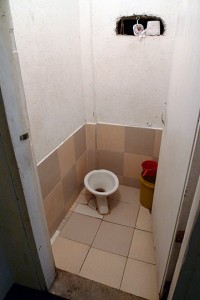
Bathroom/shower room with bucket/ladle to either flush or shower
I have not had a hot shower in days.
No, I do not smell like an overripe French cheese. I have still been able to wash. But not with hot water, and sometimes not with any running water, let alone running water from a shower head.
This is one of the joys of adventure travel. This morning, I did have running water, and a little shower head at the end of a hose tied to the wall with a string. But there was only one tap, which had a little blue dot on it, and you know what that means: prepare to go glacial.
You would think, in a tropical country, that the water would naturally be warm. Not so. The gods and the laws of physics conspire to make the water feel unnaturally cold. I’m not sure how this can be, but this is the way it is. Run the water down your bare back and every single muscle in your body will seize up and your teeth will clench in a herculean effort not to gasp out loud. After all, if you can hear everyone talking in the street below through the open-air vents, they can hear you too.
At least this morning I had some semblance of a shower. Sprinkles of water were indeed following gravity’s call and splashing down on me from above. A couple of days ago, it was the big-bucket-of-water, little-scoop washing trick. Dip the scoop in the big bucket, and pour it on you. Using a flashlight as illumination because there was no electricity. Even from the bucket, which as far as I could tell in the semi-darkness had not somehow been magically filled with ice cubes, the water was still cold. More clenching of teeth.
Funny thing is, sometimes even the bucket feels like a welcome luxury. After trekking for a few days with no reasonable washing options, I remember coming back to the bathroom/shower pictured above and feeling truly happy and pampered. It’s all relative. It’s all part of the fun.
December 10th,2008
Cambodia |
1 Comment
Help me write a funny or clever caption for this image (via comments):
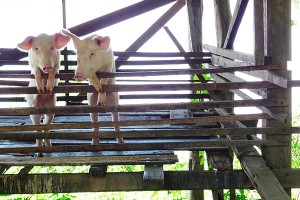
December 9th,2008
Cambodia |
15 Comments
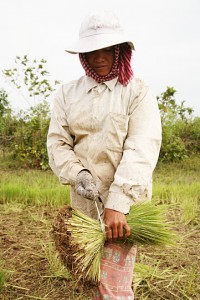
In Kampong Cham, they seed the rice then uproot and transplant for higher yields
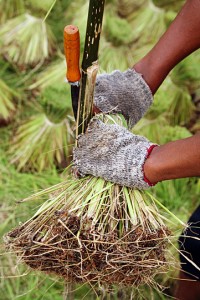
Cutting the tops to equalize the height
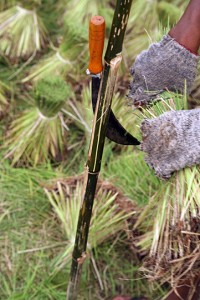
Watch your fingers
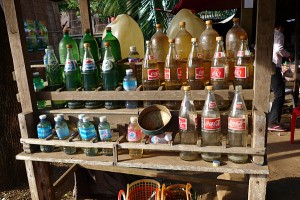
Fill up your motorbike tank by the liter
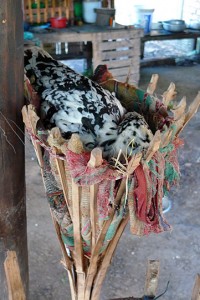
I'm a chicken, not a torch. Squawk!
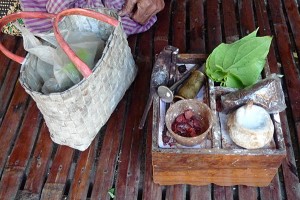
Older people mix these together inside leaves and suck on them
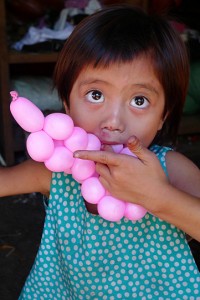
Hmm, I wonder if balloon tastes good
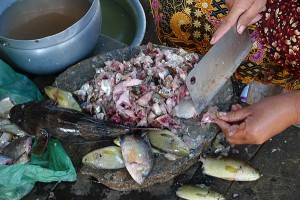
Fresh fish stew coming right up
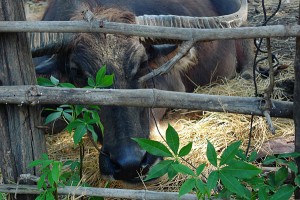
Psst, dude, help me get this rope out of my nostril
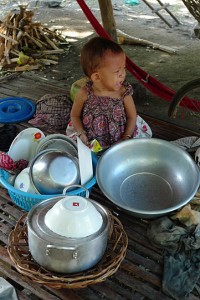
But I don't want to do the dishes!
December 9th,2008
Cambodia |
No Comments
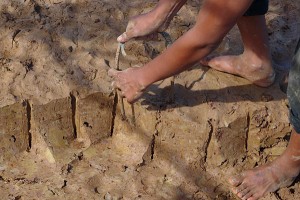
First, find some clay and use a handy wire cutter to cut off some chunks.
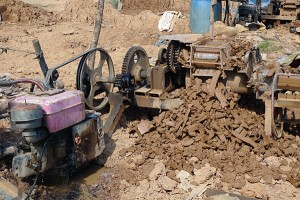
Toss the chunks of clay into this contraption
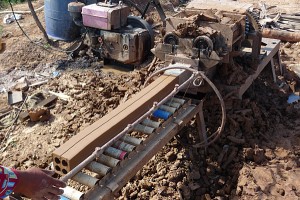
Out comes the shaped clay on the roller
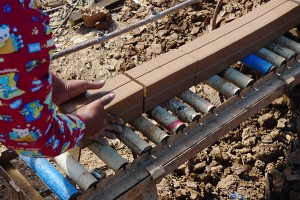
Slide the wire cutter across and pick up the fresh soft bricks
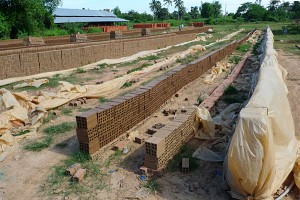
Lay the bricks out to dry before firing them in the ovens
December 8th,2008
Cambodia |
2 Comments
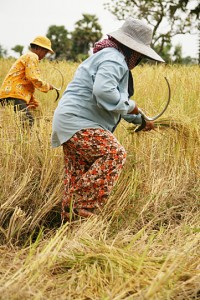 50% of the population of Cambodia is under 16 years old.
50% of the population of Cambodia is under 16 years old.
I noticed that immediately when I first came in to the capital city of Phnom Penh. I saw thousands of people, but very few over the age of 50. It’s like an entire generation has all but disappeared.
So I was particularly pleased to be able to speak with some older folks and ask them about their experiences: before, during and after the Khmer Rouge regime under Pol Pot.
Several hours north of Phnom Penh on the Mekong river, I stayed in a hut in a tiny little village just outside of Kampong Cham. Walking through the rice fields and village with the English-speaking woman whose house I was staying in, it was a wonderful opportunity to speak with the villagers and ask questions.
The woman’s parents, for instance, were married through an arranged marriage, which is the traditional method in this area. The mother had never met nor spoken to her husband-to-be until the day of their wedding. And then she found out that they didn’t get along. She said it took them months to learn to successfully cohabitate, and that to this day they are still like a “knife and cutting board,” to use her expression.
Things have changed a little bit, but not that much. Some families now allow a right of refusal, so that if the two betrothed meet and one of them has serious objections, they can refuse the marriage. This still makes for some high-stakes judgment calls, however. As it was explained to me, the prospective bride and groom may be given 15 minutes to meet and chat before the parents come back in and ask: “so, do you love each other?”
And of course there are suitors. Men who see an eligible girl who strikes their fancy (most girls marry between 17 – 19), and have their parents go to the girls’ parents to ask for her in marriage. Even if there is no interest on the girl’s part, this can create trouble: one woman explained that when she was of age, one suitor got really jealous that another man had shown interest, so he wrote her a letter threatening to toss a hand grenade into their wedding ceremony should she choose that other guy. Ah, love.
Life as a Cambodian farmer is not easy. Long hours, back-breaking work in the fields, no vacation, very little income. But it was even worse during the war.
During the Khmer Rouge period (1975 – 1979), all private land was confiscated (and money was abolished). Families were separated (men from women, women from children), and forced to work even harder in the fields. But they owned nothing of what they produced, and famine, disease and starvation were real issues.
When Vietnam “liberated” Cambodia from the Khmer Rouge in 1979 and occupied the country for the next 10 years, they imposed a different sort of communism. They created groups of 10 families and apportioned each of them plots of land to communally cultivate. At least they could be with their own families, so this was better from a social standpoint, but it was still very difficult and unproductive, and the quality of life was very poor.
Only in the 1990s after the fall of the Soviet Union and the withdrawal of communist Vietnamese troops was private ownership reintroduced. But no one got their old land back. Instead, they had what was apportioned to them from the Vietnamese, and over time families were able to sell or acquire land from others. Everyone essentially restarted from scratch.
I spoke to farmers, handicraft makers, brick makers, and teachers. Even an old Buddhist monk who donned the robes after his wife died. Now in his 70s, he says he has trouble believing that he’s no longer the strong and spry young boy he once was.
Teachers make very little money: starting in this profession will earn you all of $20 a month salary. So the teacher I met, who was filling out students’ report cards on a Sunday, also has to work supplemental hours in the fields or on the farm to make ends meet.
It is a difficult life in the village. As one person explained, it is better than during the 70s and 80s, but not as good as life before the war in the 50s and 60s. Perhaps the new generation will see their villages prosper once again.
December 8th,2008
Cambodia |
No Comments
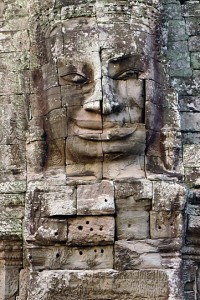 Quick, think of a powerful ancient empire.
Quick, think of a powerful ancient empire.
Chances are, the Angkor empire ruling from what is present-day Cambodia is not the first one that came to mind. And yet, from the 9th to the 15th centuries, the Khmer ruled over the greatest empire that southeast Asia has ever seen. At its height, the capital city of Angkor was home to over a million people—compare that to the 50,000 or so that lived in London at the time.
The Khmers were ruled by a succession of self-proclaimed god-kings, or devarajas. And like god-kings everywhere, there was no shortage of architectural excess among many of these, each one vying to create the most impressive temple to the Hindu deities. In this, they largely succeeded.
Although Angkor Wat is the most famous of the Khmer temples (and considered to be the largest religious structure in the world), it is but one of dozens of breathtaking temples clustered around the Cambodian town of Siem Reap, each remarkable for its own unique style and design. Pure heaven for temple aficionados.
Although I am not one to get particularly excited about ruins, these were admittedly most impressive. Roving from temple to temple from a 5:30am sunrise to a 5:30pm sunset, I was actually sorry to see the last rays of daylight. From the massive scale of Angkor Wat to the intricate carvings of Banteay Srei to otherwordly heads of Bayon, each temple was more fascinating than the next.
My absolute favorite was Ta Prohm. Uninhabited for centuries, the jungle moved in to reclaim this temple, with enormous trees now crawling out of the rocks and through doorways, their roots wrapping around spires and cleaving through walls. It is at once a beautiful display of man’s architectural glory and of nature’s even greater power.
December 6th,2008
Cambodia |
1 Comment
Some pictures from the infamous Khmer Rouge detention facility of Tuol Sleng, known as S-21 (Security Office 21).
It was difficult at first for me to take out my camera and take pictures. How do you properly photograph a prison that has caused the suffering and death of so many thousands of people? But photographs can often convey what mere words cannot, and I tried to do it justice. This place deserves not to be forgotten.
December 5th,2008
Cambodia |
4 Comments
It is estimated that some 2 million Cambodians died during the brutal reign of the Khmer Rouge between 1975 and 1979.
Many died from malnutrition, disease and exhaustion working in slave-like conditions as part of the Khmer’s ruthless and sudden imposition of communism on the entire populace. Many were summarily executed for real or imagined offenses against the regime.
And over 17,000 men, women and children were sent to Security Office 21 (S-21), the secret Khmer Rouge detention and interrogation center of Tuol Sleng. Of those 17,000, only seven survived.
Visiting this former prison in Cambodia’s capital city of Phnom Penh is a sobering and altogether depressing experience. Housed in a former high school, each new arrival to Tuol Sleng was photographed before being stripped down and shackled into small, dark, dirty and stifling cells. Hundreds of those photographs are now on display, silently accusatory ghosts from the past.
Prisoners were guarded by exceptionally cruel 10 – 15-year olds, specially selected and trained by the Khmer Rouge regime for complete lack of empathy. Prisoners were regularly beaten and sadistically tortured, regardless of age, sex or guilt. Children too. The images on display showing the gruesome results of some of these practices were disturbing, haunting, and nauseating.
After 2 – 6 months at S-21, prisoners were bound, blindfolded, loaded onto trucks and driven several miles to the extermination camp of Choeung Ek. One by one, they were made to kneel in front of newly dug pits. To save ammunition, they were bludgeoned to death using sharp or blunt instruments such as shovels, pickaxes and crowbars, then tossed into a mass grave. Those that somehow survived the beating were buried alive.
Those were my visits today. I didn’t eat much.
December 4th,2008
Cambodia |
1 Comment













































































 Click to subscribe via RSS feed
Click to subscribe via RSS feed
